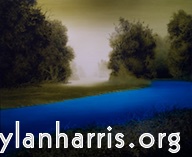
I was really grabbed by the landscapes of the Russian artist Igor Oleinikov, represented by galARTfactory from Switzerland. I’m not a comic person (the publishing form, not the funny man), yet his style reminded me in many ways of classic serious comic imaginary. I photograph woodland, and have never really quite got the spirit in an image that I feel in the trees (although I’m on to something with my current work). Oleinikov has it.
But that’s not all. There’s something about his choice of colours. Most of his works were in thin sombre colours. Yet they always included something striking in a dominant saturated colour, an element that makes no sense purely in terms of landscape, showing there’s something else in the work. Even more fun, what’s obvious from the distance is quite wrong when looked at in detail: those look like bushes and trees until you look at them closely. The gallery lady said the paintings represent memory, with a dominant element standing out in the mind, and the remainder of the image giving it a setting. It’s a very different interpretation of memory to that in my work.
Indeed, the gallery lady who spoke to me about it had the enthusiasm of a lover for Oleinikov’s work. She really did like it. She kindly allowed me to take the photo shown here. I’ve kept it small in respect of the gallery; the images on their site are small too.
The Belgian Gauthier Fabri’s real job is wedding photographer, but he produces some gorgeous abstract photographs too. . He will take a high definition detailed shot of something, sometimes deliberately incorrectly, minimise it (minimise as in Reich, not Windows), then add in texture, colour, elements, until he has found a new balance that allows the now abstract photo to say what he wants it to say. The results are stunning. Take a look at For example, this image, which was originally a close up of a Zebra’s coat.
All in all, my time was very well spent there. I came out hugely impressed, and pretty exhausted. I’ll be going there next year. I think I might have found a few ideas to steal, too.